Slovenian Economic Mirror
Related Files
Slovenian Economic Mirror 1/2024
Most available short-term economic indicators for Slovenia improved at the end of 2023, but with the exception of construction and certain segments of household consumption, they have mostly not reached the level of a year ago. After two months of growth, trade in goods fell again in November, but it was on average higher in October and November than on average in the third quarter. Since September, manufacturing output has increased in all industry groups according to technology intensity. The effect of high energy prices, which had the greatest impact on energy-intensive industries, started to ease gradually, while manufacturing output in November was still slightly lower year-on-year. According to data on the value of construction work put in place, construction activity remained unchanged in November, although it was one-fifth higher between January and November than in the same period of 2022. Sentiment in Slovenian economy further improved month-on-month in December but remained lower than a year ago. Year-on-year growth in the number of persons in employment and decline in the number of unemployed slowed at the end of last year. Between January and October, the average gross wage rose by just under 2% in real terms, with the highest growth in the private sector being recorded in the activities facing the greatest labour shortages. Year-on-year inflation fell to 4.2% at the end of last year and more than halved compared to December 2022. Compared to the start of the year, this was mainly due to lower growth of food prices and lower energy prices, with the latter also being affected by government measures in November and December. The year-on-year increase in service prices has also slowed, particularly in December, although it remains high. In the selected topic, we summarise the results of the Eurobarometer survey on life satisfaction, which remains at the highest level ever recorded in Slovenia and well above the EU average. The proportions of respondents citing price growth and energy supply as their main concerns decreased noticeably in 2023, although price growth remains the most frequently cited problem at the personal and national levels.
Related Files
- International environment
- Economic developments
- Labour market
- Prices
- Prices
- Balance of payments
- Public finance
Composite Purchasing Managers’ Index (PMI) for the euro area, December 2023
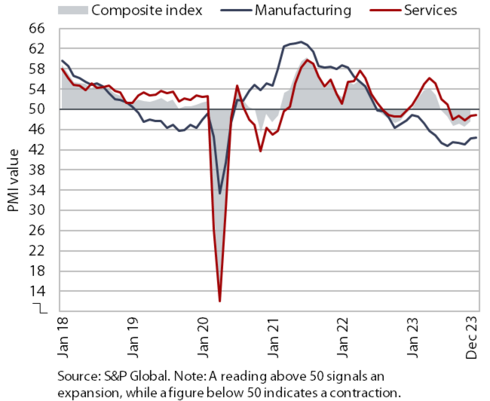
Sentiment indicators for the euro area suggest that the dynamics of economic activity remained weak in the fourth quarter of 2023. After falling to its lowest level in three years in October, the composite Purchasing Managers’ Index (PMI) for the euro area improved slightly in November and remained unchanged in December (47.6). Both indicators that form the composite PMI (i.e. for manufacturing and services) are still below the 50 mark (the threshold between economic expansion and contraction). The Economic Sentiment Indicator (ESI) for the euro area, which has been below its long-term average since July 2022, improved in December. Sentiment improved in all activities and among consumers. In December, the economic climate remained largely unchanged compared to a year ago, while confidence was significantly higher among consumers and significantly lower in manufacturing and construction. The survey indicators therefore suggest that activity probably began to recover in the fourth quarter of last year but remained weak.
ECB economic outlook, December 2023
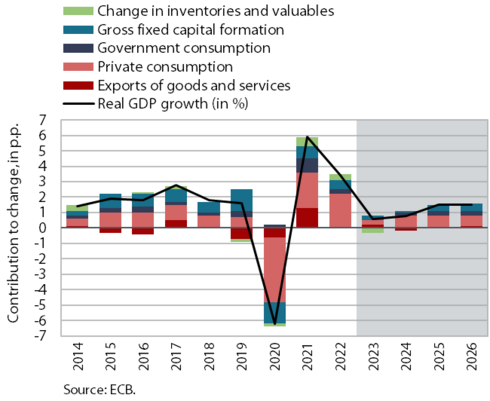
Similarly to the forecasts of other international institutions, according to the ECB’s December forecast, euro area economic growth is expected to gradually recover slightly in the coming quarters. Euro area GDP in the third quarter of 2023 was down 0.1%, reflecting a negative contribution to growth from destocking, and survey indicators point to weak activity also in the fourth quarter of 2023. Some international institutions (the ECB and EC) estimate in their latest forecasts that economic activity picked up in the final quarter of last year and that the gradual strengthening of growth will continue in the coming quarters. GDP growth is expected to strengthen this year and next, mainly driven by rising private consumption supported by increased confidence, low unemployment and wage growth, and a further decline in inflation. Tight financing conditions are expected to continue to have a negative impact on growth, but this impact will fade gradually. The ECB estimates that euro area GDP rose by 0.6% in 2023 and forecasts that it will strengthen to 0.8% and 1.5% in 2024 and 2025 respectively according to the baseline scenario. The outlook is surrounded by high uncertainty related to a potential escalation of the conflict in the Middle East, which would have a negative impact on the euro area economy, particularly through higher energy prices and increased uncertainty. According to the ECB’s alternative scenario, euro area economic growth would be 0.7 p.p. lower in 2024 and 0.3 p.p. lower in 2025 than in the baseline scenario.
Commodity prices, December 2023
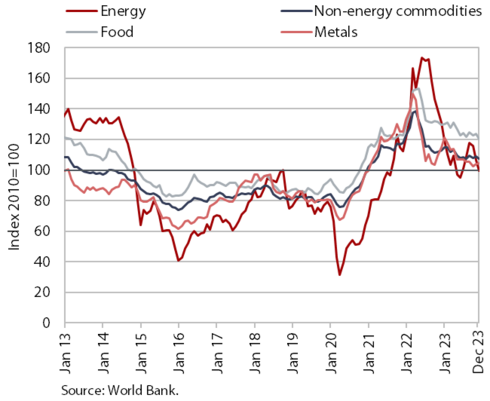
Brent oil prices continued to fall in December 2023; prices for non-energy commodities have been largely unchanged for several months. The average dollar price of Brent crude oil in December was USD 77.8 (-6.2% month-on-month) and the euro price was EUR 71.3 (-7.2% month-on-month). After a significant oil price rise in September due to Saudi Arabia and Russia’s decision to extend their production cuts, the start of the war in the Middle East had no impact on the average price until the end of last year. Year-on-year, the dollar Brent oil price was 4% lower in December and the euro price was 6.8% lower. In 2023, the oil price in dollars or euros was on average around 20% lower than in 2022. The euro prices of natural gas on the European market (Dutch TTF) fell in November and December after an increase in October related to oil extraction problems at some fields and damage to the Baltic Sea pipeline, while they were 69% lower year-on-year in December. According to the World Bank, the average dollar price of non-energy commodities has remained almost unchanged since the summer, while it was 5.2% lower year-on-year in December.
Effective exchange rates, Q3 2023
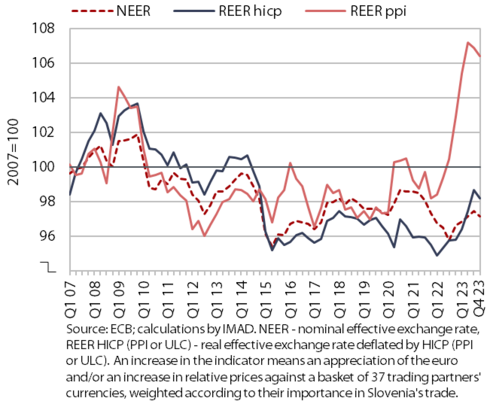
Although the values of the competitiveness indicators improved in the fourth quarter of 2023, they still point to unfavourable price competitiveness of Slovenian exporters. As price growth in Slovenia was stronger than in its trading partners, the price competitiveness indicators of the Slovenian economy (REER ppi and REER hicp) deteriorated sharply last year. The appreciation of the euro against a basket of currencies of Slovenia’s main trading partners (NEER) also contributed slightly to the deterioration. The gap in price growth was particularly pronounced for industrial producer prices in manufacturing (PPI), which peaked in the second quarter of 2023, according to currently available data.
Short-term indicators of economic activity in Slovenia, October–November 2023
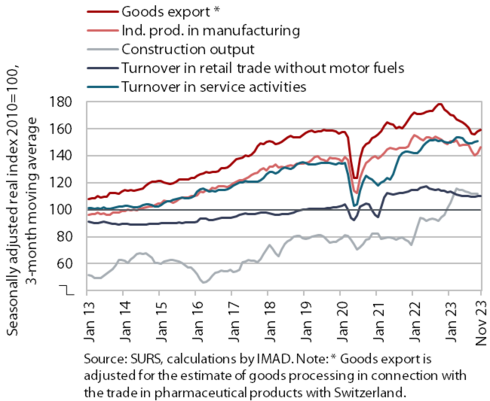
Most available short-term economic indicators for Slovenia improved at the end of 2023. However, with the exception of construction and some segments of household consumption, they have largely not reached the level of a year ago. After two months of growth, trade in goods contracted again in November amid ongoing weak activity and uncertain situation in Slovenia’s main trading partners. The values of the competitiveness indicators improved slightly in the fourth quarter of 2023 after a long period of negative developments but still point to unfavourable price competitiveness of Slovenian exporters. Slovenia’s export market share in the EU market increased again year-on-year in the third quarter but still did not exceed the levels recorded before the energy crisis. Production volume in manufacturing, which began to rise in all industry groups according to technology intensity in September 2023, was still lower in November than a year ago. The effects of high energy prices, which had the greatest impact on energy-intensive industries, started to ease gradually in the autumn months. According to data on the value of construction work put in place, construction activity remained unchanged in November, although it remained one-fifth higher between January and November 2023 than in the same period a year earlier. Real turnover in most trade sectors rose in October after several months of decline, while real turnover in market services decreased again and remained similar to the same period a year earlier. Trade in services decreased slightly in October but remained close to its peak. Household consumption picked up in the fourth quarter. In December, the value of the economic sentiment indicator rose compared to November, while it remained lower year-on-year.
Electricity consumption, December 2023
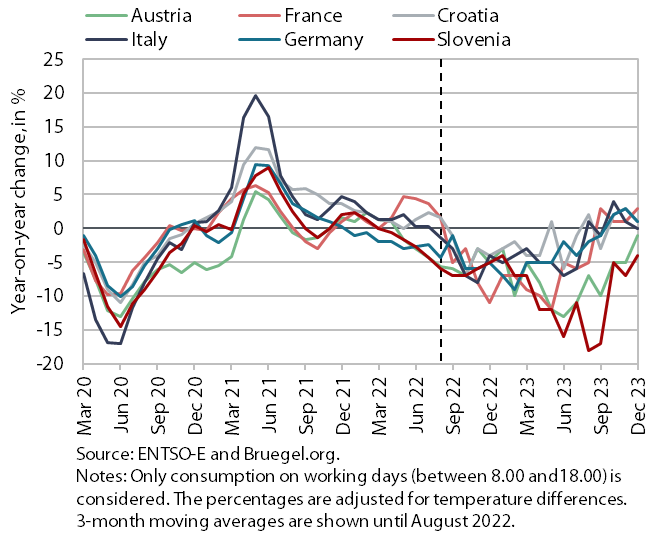
Electricity consumption was 4% lower year-on-year in December 2023. The year-on-year decline was lower than in previous months, partly due to the resumption of part of production at a large direct consumer (the company SIJ Acroni) and the resumption of production lines at companies affected by the floods in August. The smaller year-on-year decline was also due to a relatively low base at the end of 2022, which was caused by high electricity prices and a slowdown in economic activity. Among Slovenia’s main trading partners, lower consumption compared to December 2022 was recorded also by Austria (-1%), while consumption in other trading partners was higher year-on-year, in Italy, Germany and Croatia by 1%, and in France by 3%.
Electricity consumption by consumption group, November 2023
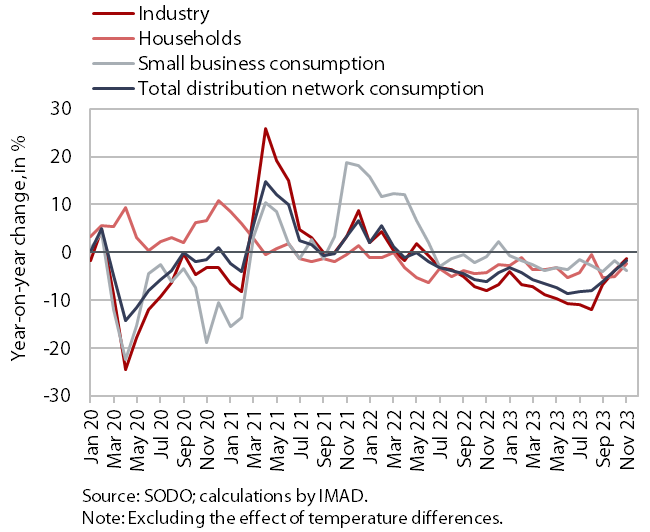
Electricity consumption in the distribution network in November 2023 was lower again year-on-year, but the decline was less pronounced than in previous months. Industrial consumption recorded a small year-on-year decline (1.2%), which was partly due to a relatively low base in 2022, most likely related to the slowdown in economic activity and high electricity prices. Household consumption fell by 2.3% year-on-year in November, while small business consumption fell by 3.9% year-on-year.
Value of fiscally verified invoices – nominal, December 2023
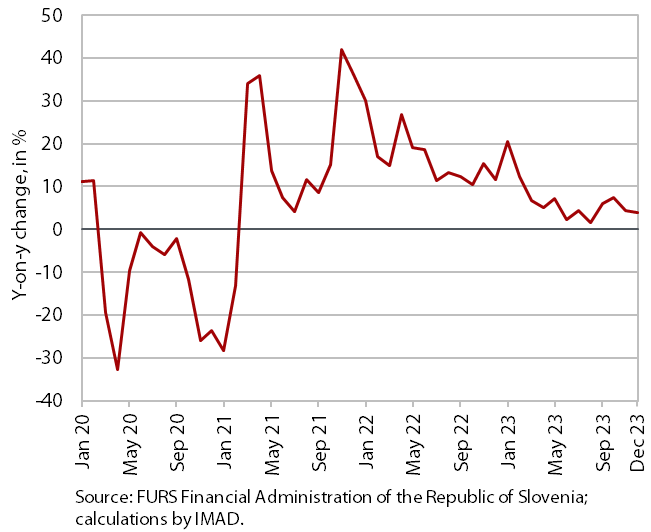
The nominal value of fiscally verified invoices was 4% higher year-on-year in December 2023. With two working days less than in December 2022, year-on-year growth in total turnover was similar to that in November. In trade, which accounted for almost 80% of the total value of fiscally verified invoices, turnover growth was lower than in the previous three months (at 3%, against 5% in November and 7% in October). Growth was lower in all three main trade segments. In retail trade it was 3%, in the sale of motor vehicles 11% and in wholesale trade 3% lower year-on-year. Year-on-year turnover growth in accommodation and food service activities, certain creative, arts, entertainment and sports services, and betting and gambling accelerated (overall growth in accommodation and food service activities and in other service activities increased from 8% to 12%).
Trade in goods – in real terms, November 2023
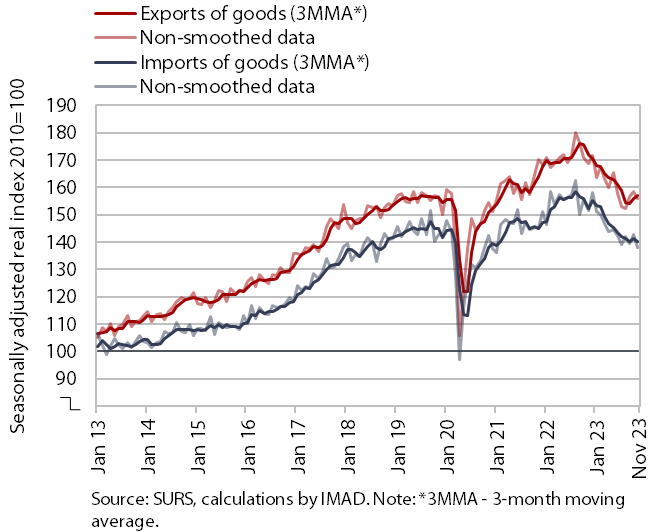
Trade in goods fell slightly in November 2023 and the year-on-year decline deepened. After two months of growth, real exports of goods fell by 1.7% and imports by 3.5%. Nevertheless, the average trade in goods in October and November was still above the average of the third quarter (seasonally adjusted). In the first 11 months, exports fell by 7.1% year-on-year and imports by 7.5%. In a year-on-year comparison, the decline in exports was more pronounced with EU countries (EU: -8.2%; non-EU: -2.7%), while the decline in imports was more pronounced with non-EU countries (EU: -5.9%; non-EU: -13.0%). According to the available data, imports of intermediate goods imported by Slovenia from non-EU countries (e.g. iron and steel and non-ferrous metals) and exported to the EU (e.g. metal products and machinery) have decreased in particular. Although sentiment in export-oriented activities deteriorated slightly in December, it improved quarter-on-quarter in the fourth quarter of 2023. Amid great uncertainty in the international environment, export orders remained significantly lower than at the start the year.
Slovenia’s export market share in the EU market, Q3 2023
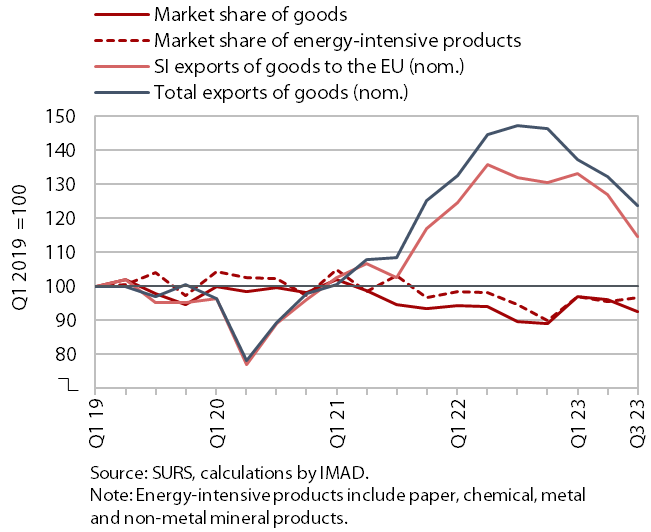
Slovenia’s export market share in the EU market increased again year-on-year in the third quarter (by 3.5%) but still did not exceed the levels recorded before the energy crisis. Slovenia’s export market share in the EU market decreased by 2.0% and 5.5% in 2021 and 2022 respectively. The decline was particularly pronounced in the second half of 2022, due in particular to stagnation in energy-intensive products. Preliminary estimates suggest that the decline in market share during the energy crisis was to some extent temporary and related to the rationalisation of production at a time of great uncertainty about energy supply and prices, as it increased year-on-year in the first three quarters of 2023 (by 3% on average). However, growth in the first three quarters of last year was not enough to bring the market share back to the level of two years ago. This was due to the loss of price competitiveness in the meantime and the structure of exports; among the product groups, road vehicles in particular contributed negatively to the growth in market share.
Trade in services – nominal, October 2023
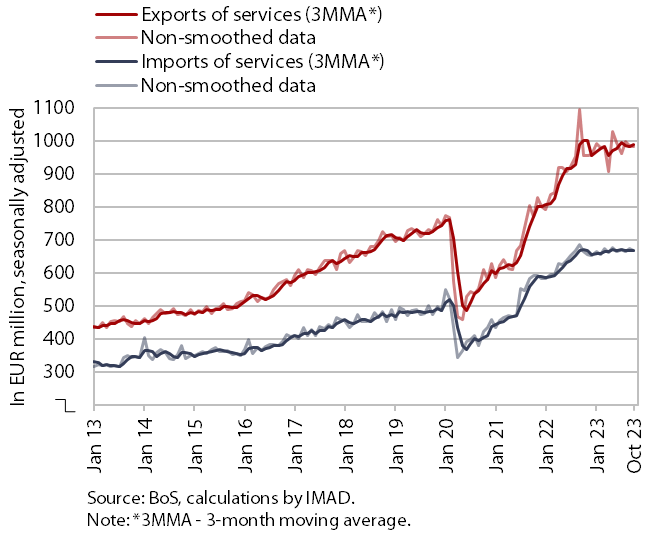
Trade in services decreased slightly in October 2023 but remained close to its peak, mainly due to the growth of trade in tourism-related services. Compared to the previous month, exports of services fell by 0.3%, mainly due to a further decline in exports of transport services, while exports of construction and other business services also fell after a significant increase in September. Exports of tourism-related services rose again and reached their highest level to date (seasonally adjusted). Imports of services fell by 0.7%, while imports of most major service groups, ex cept ICT services, including tourism-related services, declined (seasonally adjusted). In the first ten months of 2023, exports of services rose by an average of 6.4% year-on-year and imports by 4.7%. The year-on-year growth was mainly due to a significant recovery in trade in tourism-related services. Exports and imports of transport services fell markedly (by -4.7% and -8.3% respectively), which we believe was mainly due to a decline in trade in goods and activity in manufacturing in Slovenia and its main trading partners.
Production volume in manufacturing, November 2023
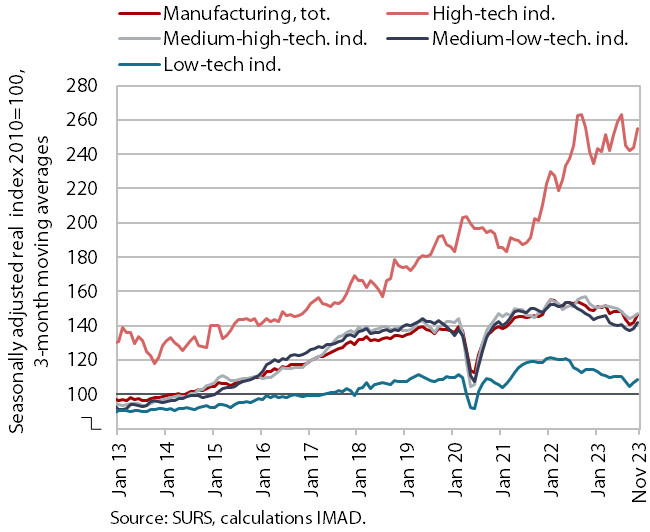
Production volume in manufacturing, which started to strengthen in September 2023, was still lower in November than a year ago. After bottoming out in August 2023, manufacturing production has risen in all industry groups according to technology intensity since the end of the third quarter. Against the backdrop of monthly production growth and the low base effect (influenced by high energy prices), the year-on-year decline in production weakened in October and November 2023. The effect of high energy prices, which had the greatest impact on energy-intensive industries, started to ease gradually. Only in the paper industry did the year-on-year decline in the final months of 2023 remain similar to the average for the first nine months of 2023 (around 20%), while in the other sectors the year-on-year decline was smaller or production increased year-on-year (in the manufacture of basic metals also due to the resumption of part of the production of a large direct customer). The year-on-year decline in most other manufacturing activities has also slowed since the middle of the third quarter, and production in October–November was on average around 0.5% lower than in the same period in 2022. In the first 11 months of 2023, manufacturing output was on average 3.2% lower year-on-year.
Activity in construction, November 2023
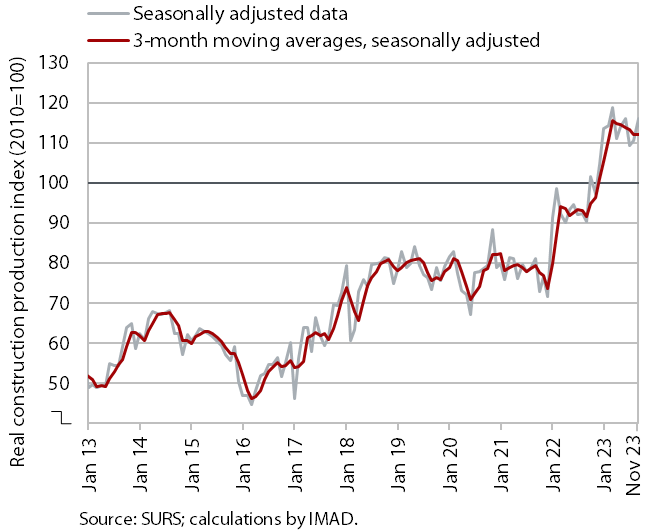
According to data on construction put in place, construction activity in November 2023 remained unchanged compared to the previous month but was higher than a year earlier. After a sharp rise in the value of construction put in place at the start of 2023, activity fluctuated greatly in the following months and was slightly lower in October and November than at the start of the year. The total value of construction put in place was 20% higher in the first 11 months of 2023 than in the same period of 2022. In this comparison, activity was higher in all three segments covered by the statistics: in specialised construction by 32%, in civil engineering by 21% and in building construction by 11%.
Some other data, however, point to much lower growth in construction activity. According to VAT data, the activity of construction companies in the first 11 months of 2023 was only 11% higher than a year earlier. Compared with data on the value of construction put in place, the difference shown in the growth of this activity was thus 9 p.p.
Turnover in trade, October–November 2023
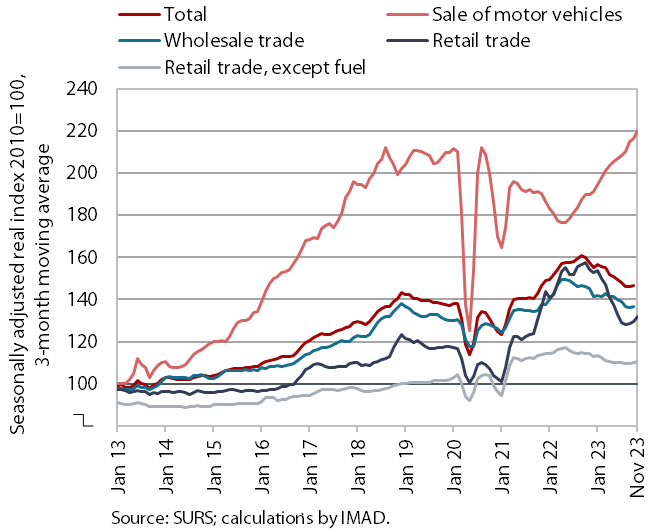
Real turnover in most trade sectors increased in October 2023 after falling in previous months. In retail trade (excluding automotive fuels), with relatively high current growth, it was higher year-on-year for the first time in 2023. This was due to growth in the sales of non-food products, while the sales of food, beverages and tobacco were similar to October 2022. Turnover in wholesale trade also increased for the second month in a row, though still falling short of 2022 turnover. The high year-on-year growth was maintained by turnover in the sales of motor vehicles (18%), which was the only major trade segment to also exceed 2022 sales in the first ten months of the year. According to preliminary SURS data, this intensified in November, while turnover in retail trade was again slightly below the previous year’s figure.
Turnover in market services, October 2023
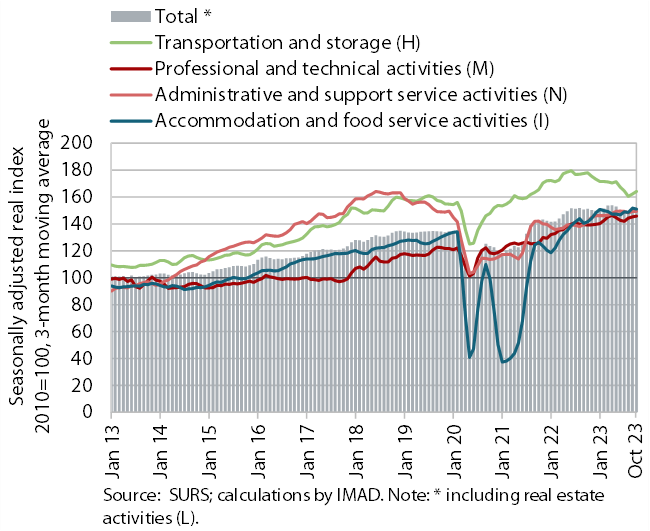
Real turnover in market services fell in October 2023. Total turnover fell by 1.3% in current terms, after having risen quite sharply in the previous month. The decline was due to a fall in turnover in accommodation and food service activities and in administrative and support service activities, which recorded strong growth in September. Turnover growth in other service activities was modest. In transportation and storage, where a negative trend had continued since May 2022, turnover increased, particularly in port traffic. Turnover growth in information and communication activities was mainly due to the increase of sales in computer services on the domestic and foreign markets. Turnover in professional and technical activities stagnated. Total turnover in market services rose by 1.4% year-on-year in real terms in October and by 1.5% in the first ten months of last year, driven by growth in most activities, with the exception of transport. In employment services, it remained below pre-epidemic (October 2019) levels (by 21%).
Selected indicators of household consumption, October–December 2023
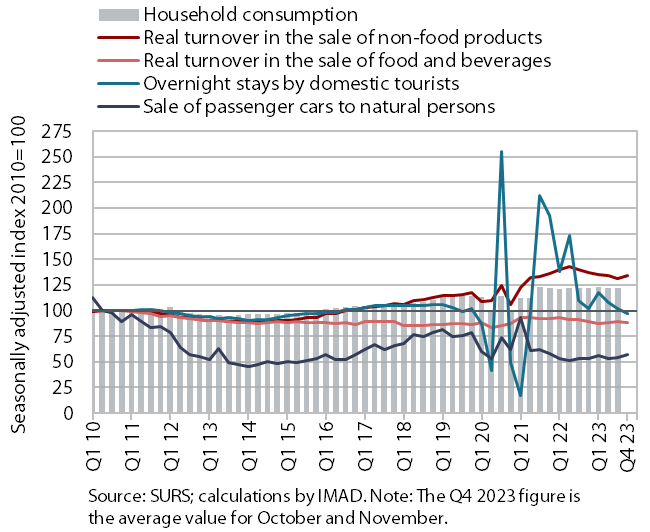
The available data point to a recovery in household consumption in the fourth quarter of 2023. The sales of new passenger cars to private customers increased by 16% year-on-year in October and November on average after declining year-on-year in the third quarter. Spending on tourism services outside Slovenia also increased year-on-year in October (by 6% in nominal terms), with the number of overnight stays by Slovenians in Croatia similar to a year earlier. Household spending on non-food products and food, beverages and tobacco was slightly lower year-on-year on average in October and November (down 1% in real terms), but the decline recorded in the previous quarters reduced significantly. The revival in consumption in the last quarter of last year is also evident from the stronger year-on-year growth in the nominal value of fiscally verified invoices (6%), which was positive again in real terms after two quarters of decline.
Economic sentiment, December 2023
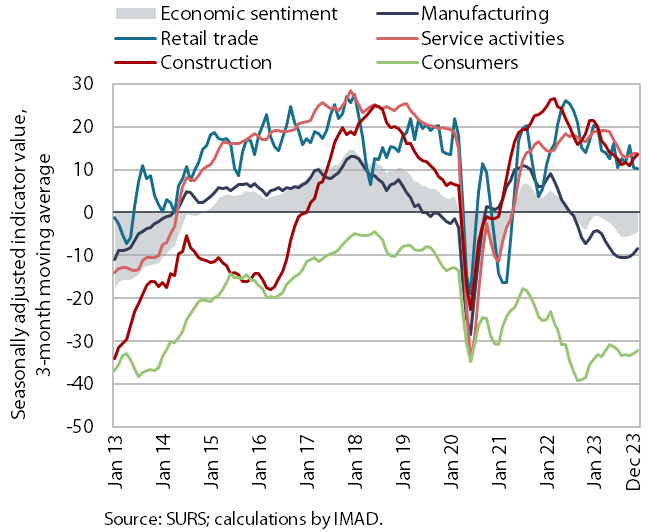
The economic sentiment indicator further increased month-on-month in December 2023, while it was still down year-on-year. Compared to the previous month, confidence was higher in retail trade, slightly higher in construction, manufacturing and among consumers, while it remained unchanged in services. Compared to December 2022, confidence was lower in all activities, while it remained unchanged among consumers (in 2022 it had fallen significantly due to lower purchasing power as a result of rising prices). On average for 2023, it was slightly higher year-on-year only among consumers, where it was still the furthest behind the long-term average in December. Confidence in manufacturing was also significantly below the long-term average. Confidence in retail trade and services averaged slightly above the long-term average in 2023, while confidence in construction was already well above it.
Real estate, Q3 2023
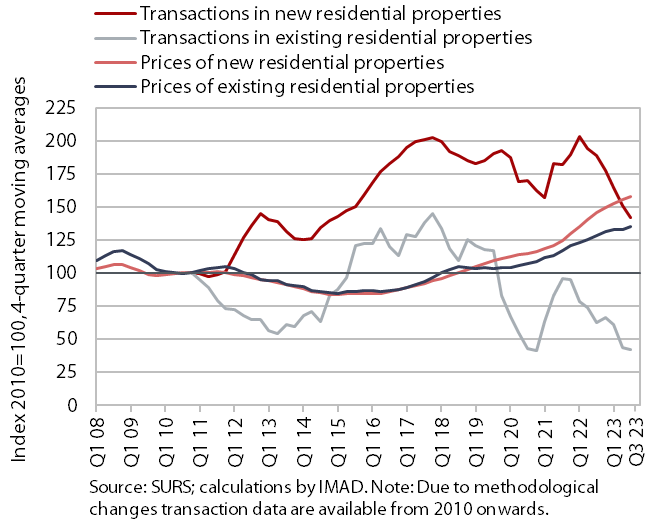
In the third quarter of 2023, the growth of dwelling prices weakened further amid the further decline in the total number of transactions. Prices rose by 0.7% compared to the second quarter and by 5.7% compared to the third quarter of 2022. Quarter-on-quarter growth was driven by relatively strong price growth in newly built dwellings (11.5%), with the number of sales rising to 4% of total transactions in the third quarter. However, for the first time since the last quarter of 2019, prices of existing dwellings fell in current terms (by 0.2%); the number of sales also continued to decline. A total of 2,397 dwellings were sold. This is a drop of more than one-fifth compared to the third quarter of 2022 and the lowest level since the second quarter of 2020, when the number of transactions was severely affected by business restrictions due to the outbreak of the epidemic.
Households facing financial distress, December 2023
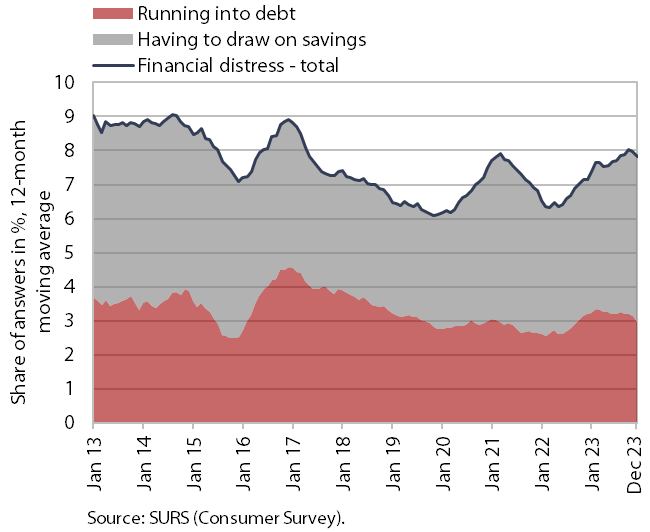
The financial situation of households improved slightly over the last quarter of 2023 compared to the previous quarter and year-on-year. Compared to the previous quarter, the share of households from the lowest-income quartile facing financial distress decreased by 4.9 p.p. (by 1.7 p.p. year-on-year). According to our estimate, this was partly due to a gradual slowdown in inflation, greater predictability in energy prices and developments on the labour market (high demand for labour). The financial situation of households from the second quartile deteriorated again (by 3.5 p.p. year-on-year). The share of households facing financial distress having to draw on savings to meet their needs and the share of households running into debt deceased slightly.
Number of persons in employment, October 2023
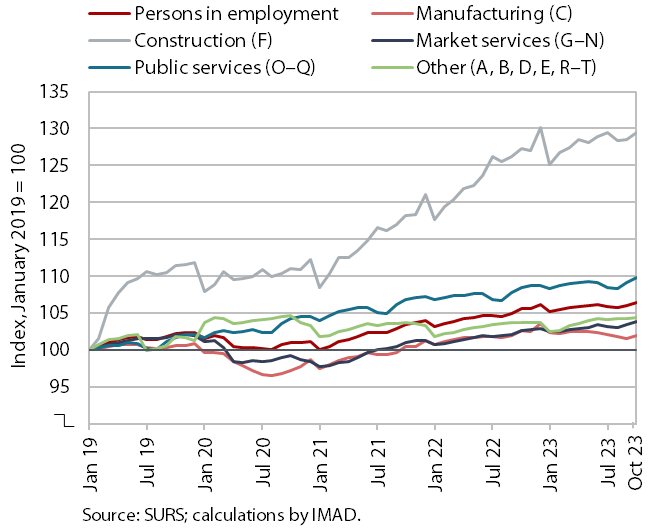
Year-on-year growth in the number of persons in employment (0.8%) continued to slow in October 2023. This was mainly due to the decline in the number of persons in employment in manufacturing in October (according to seasonally adjusted data). The overall year-on-year increase in the number of persons in employment was due to a higher number of employed foreign nationals, while the number of employed Slovenian citizens was lower. The share of foreign citizens among all persons in employment was 14.7% in October, 0.9 p.p. higher than a year earlier. Activities with the largest share of foreigners are construction (48%), transportation and storage (33%), and administrative and support service activities (27%).
Number of registered unemployed, December 2023
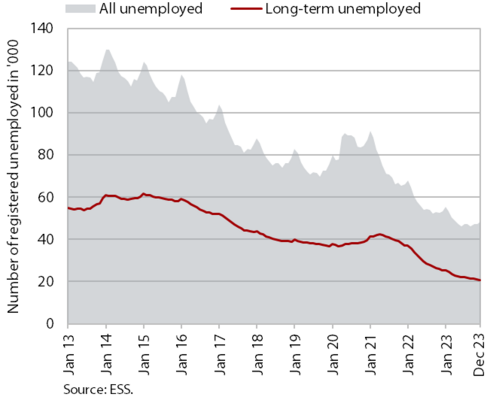
According to the seasonally adjusted data, the monthly decline in the number of registered unemployed in December 2023 (0.8%) was similar to previous months but lower than at the beginning of the year. According to the original data, 48,353 people were unemployed at the end of December, 2.5% more than at the end of November. This largely reflects seasonal trends related to a higher inflow into unemployment due to expiry of fixed-term employment contracts. Unemployment was down 9.1% year-on-year. Amid labour shortages, the number of long-term unemployed (more than one year) was almost one-fifth lower year-on-year at the end of December. In 2023, 48,709 persons were registered as unemployed on average, 14% fewer than a year earlier.
Number of FSA beneficiaries and UB recipients, November 2023
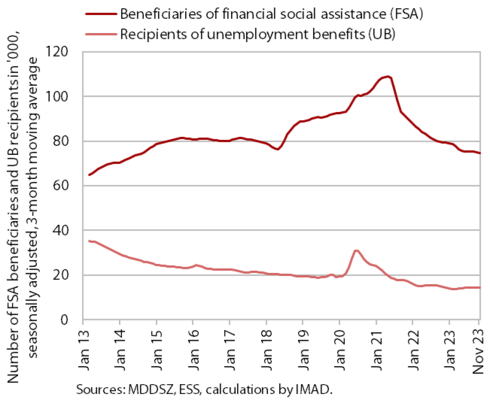
In November, the number of financial social assistance (FSA) beneficiaries and unemployment benefit (UB) recipients was lower year-on-year. Amid high employment and a fall in the number of long-term unemployed, who are often eligible for FSA, the number of FSA beneficiaries has been declining since February 2023. In November, 72,738 people were entitled to FSA (original data), which is 6.7% less than in November 2022. Among the FSA beneficiaries, 20,250 were registered as unemployed. The number of UB recipients was also lower year-on-year, by 2.7% (13,674 people according to original data).
Average nominal gross wage per employee, October 2023
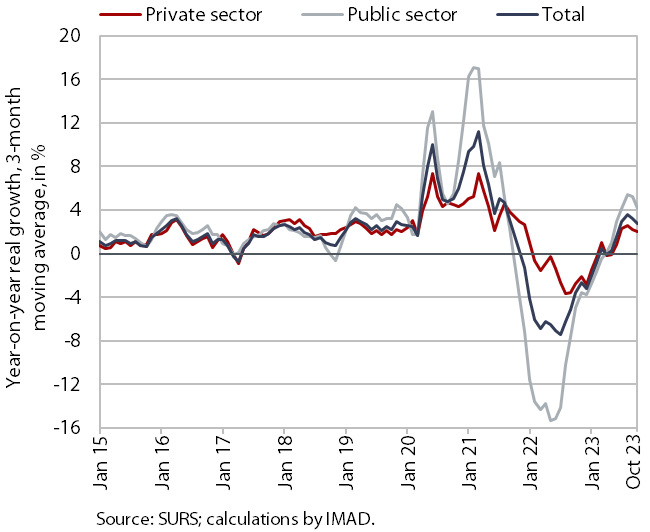
The average wage growth in October 2023 (2.2%) was slightly higher in real terms than in the previous month (1.8%). It stood at 2.3% in the private sector. It was highest in administrative and support service activities, which (along with construction and accommodation and food service activities) are among the activities facing the greatest labour shortages. In the public sector, it was 1.9% year-on-year in real terms, lower than in previous months. Growth was lower mainly due to the agreement on wage increases (the first of which took place in October 2022). Nominal year-on-year growth in the average gross wage in October was slightly lower than in previous months, at 9.2%. Growth in the private sector was 9.4% and in the public sector 8.9%. In the first ten months, the average year-on-year gross wage growth was 1.8% in real terms (1.4% in the private sector and 2.5% in the public sector). Year-on-year nominal growth in the same period was 10% (9.6% in the private sector and 10.8% in the public sector).
Consumer prices, December 2023
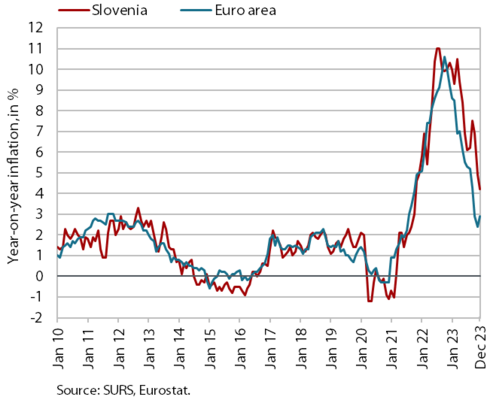
Year-on-year growth in consumer prices slowed markedly again in December 2023, to 4.2% (by 0.7 p.p.), and more than halved compared to the same month in 2022 (10.3%). This time, the main reason for the slowdown was lower year-on-year growth in services prices, which had been running at around 8% since April last year but began to weaken in the last two months, reaching 6.1% in December. The slowdown in the growth of services prices in December mainly came from year-on-year lower prices in the telephone and telefax services group (-0.1%), especially for mobile telephony services. With a significant monthly price fall (of 8.5%), the contribution of refuse collection was also lower. The contributions of some other services, which together account for more than half of the services included in the consumer price index, were also lower or at least remained unchanged. Food price inflation continued to gradually weaken year-on-year and, at 4.2%, was only at around one-fifth of the level at the start of 2023. The price increase for non-energy industrial goods is also moderating. Prices for semi-durable goods rose by 2.1% year-on-year, while prices for durable goods fell by 0.3%, as car prices were 3.3% lower year-on-year. Against the backdrop of government measures to mitigate the consequences of high energy prices and favourable developments on the markets for oil and solid fuels, energy prices were 2.3% lower year-on-year. Compared to the beginning of the year, lower growth of food prices and lower energy prices in particular contributed to the slowdown in inflation.
Slovenian industrial producer prices, November 2023
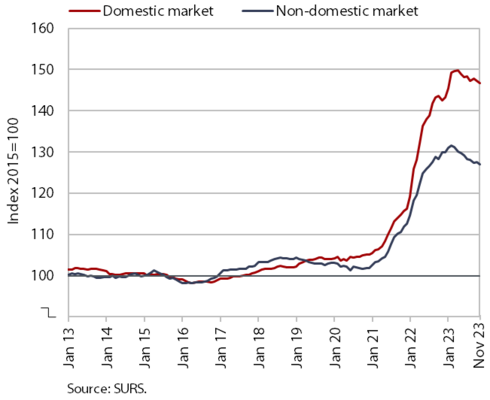
Slovenian industrial producer prices continued to fall in November and were only slightly above the level of a year earlier. They fell by 0.4% month-on-month, with a similar fall in prices on the domestic and foreign markets. The year-on-year growth rate, which had been close to 20% at the beginning of 2023, moderated further to 0.3%, the lowest since December 2020. The slowdown in year-on-year growth was still mainly due to developments in the intermediate goods group, where prices were 3.7% lower in November than a year earlier. In most other groups, with the exception of energy, the year-on-year price increase is gradually weakening. Although energy prices fell by 4.3% month-on-month, they were 7.1% higher year-on-year due to a lower base, and this was the highest increase of all product groups. On the other hand, the year-on-year price increase for capital and consumer goods continued to weaken gradually and was slightly below 4%.
Growth in loans to domestic non-banking sectors, November 2023
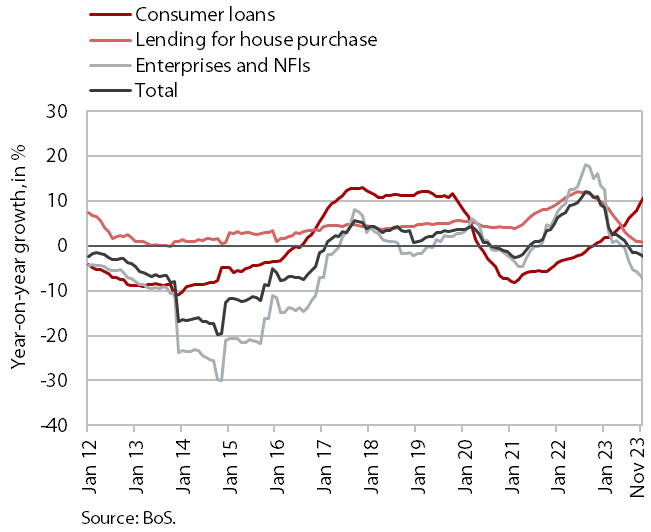
The year-on-year contraction in the volume of loans granted to domestic non-banking sectors continued in November 2023 (down 2.5%). The volume of corporate and NFI loans continued to shrink in current terms in the face of weakening economic activity and higher interest rates and was already 7.8% lower year-on-year, the sharpest decline since November 2016. The year-on-year growth in household loans (3.6%) increased slightly in November as consumer and other loans (overdrafts) increased. In addition to the lowering of threshold for creditworthiness at the beginning of the second half of last year, we believe that this was also due to a certain extent to the recovery in consumption suggested by the indicators for the last quarter of 2023. Growth in housing loans, which was only 0.7% year-on-year in November, continues to gradually slow. Year-on-year growth in domestic non-banking sector deposits fell below 4% in November. Their maturity structure is improving gradually. Overnight deposits, which still account for about 80% of all deposits (almost 85% at the end of 2022) therefore fell by 1.7% year-on-year, while term deposits increased by just over one-third amid higher deposit interest rates. The quality of banks’ assets remains solid and the share of non-performing loans is still at 1%.
Bond, Q4 2023
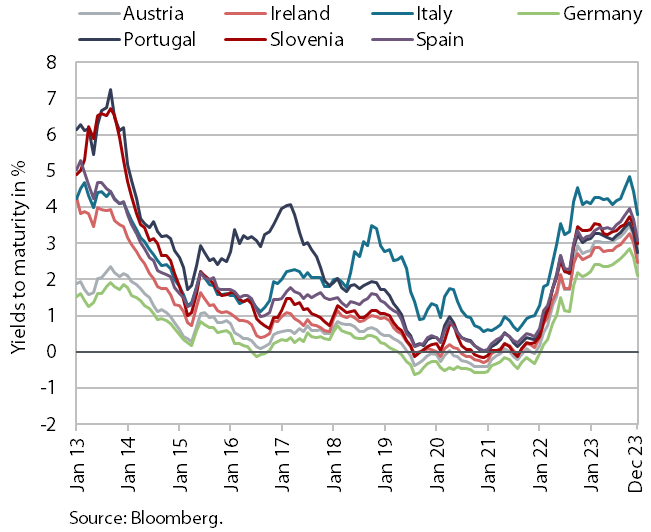
Yields to maturity of euro area government bonds decreased in the last quarter of 2023. After yields were still rising in October, they began to fall as inflation eased and the ECB was expected to discontinue its interest rate hikes. The fall was most noticeable in December, when the yield on Slovenian bonds fell below 3% for the first time since September 2022. In the last quarter of last year, it fell by 4 basis points compared to the previous quarter, to 3.41%. A similar quarter-on-quarter increase was seen in the spread to the German bond, which reached 89 basis points, a good quarter less than in the same period a year earlier.
Current account of the balance of payments, November 2023
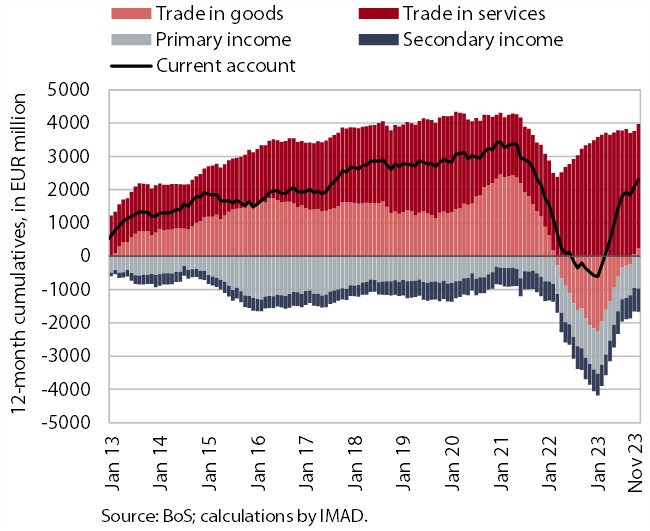
The current account of the balance of payments in the first 11 months of 2023 recorded a surplus of EUR 2.6 billion, compared to a deficit of EUR 239.9 million in the same period of 2022. The main reason for the significant year-on-year change in the current account balance is the goods trade balance, which, with imports falling more sharply than exports, once again showed a surplus. The growth of the services surplus continued, especially in trade in transport services. The decline in imports of transport services was much larger than the decline in exports, which is related to the development of trade in goods, where the decline was also larger for imports, and to the lower activity in manufacturing in 2023. Growth in the services surplus was also driven by trade in construction services and other knowledge-based services (telecommunications, computer and information services, financial services, and research and development services). The primary income deficit was lower year-on-year, mainly due to lower net outflows from equity income (dividends and profits) and higher net interest receipts from abroad. The higher secondary income deficit stemmed mainly from higher pension transfers to foreign countries. The 12-month balance of the current account of the balance of payments showed a surplus of EUR 2.3 billion in November (3.7% of estimated GDP).
Revenue of the consolidated general government budgetary accounts, November 2023
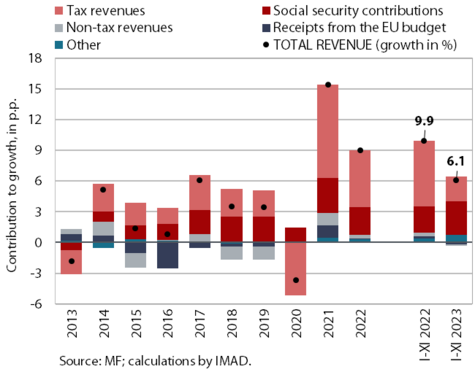
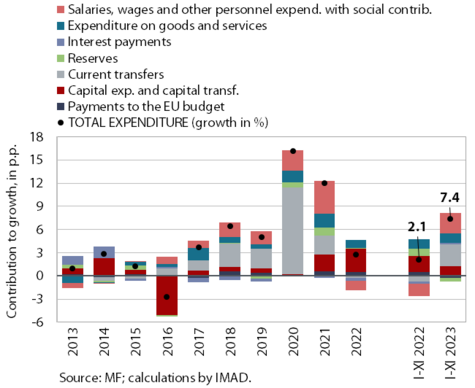
At EUR 1,081.3 million, the consolidated general government deficit in the first 11 months of 2023 was EUR 332.5 million higher than in the same period of 2022. Revenues in the first 11 months of 2023 were 6.1% higher year-on-year. The strongest revenue growth was seen in excise duties, due to an increase in excise duties on energy products and tobacco, and in social contributions, boosted by higher wage growth, and in personal income tax. Certain capital and transfer revenues were also higher. Revenue from corporate income tax declined markedly due to the lower last balancing payment of tax. Against the backdrop of weakening economic activity, overall tax revenue growth was also dampened by a slowdown in VAT revenue growth, which was also affected by the reduction in the VAT rate on energy products until September last year. Revenues from the EU budget declined year-on-year but were higher in 2023 as a whole due to the inflow of funds in December based on the second payment request under the Recovery and Resilience Facility (RRF). Expenditure in the first 11 months of 2023 was 7.4% higher year-on-year. This was mainly due to growth in wages and other remunerations, which were influenced by the agreement on wage increases in the public sector, and other current transfers (subsidies for companies to mitigate the consequences of rising energy prices and flood recovery and transfers to the social insurance funds). Growth in capital expenditure remained high (13.9%). By the end of November 2023, EUR 453 million had been disbursed from the state budget to rectify the consequences of floods and landslides and EUR 480 million to mitigate rising energy costs.
EU budget receipts, November 2023
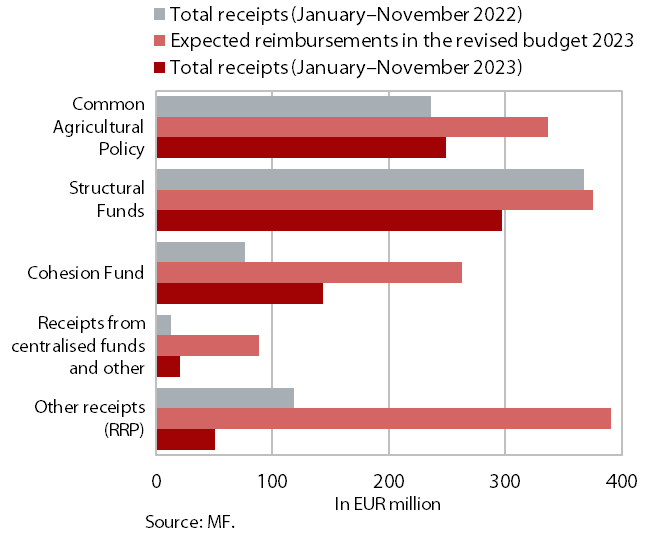
Slovenia’s net budgetary position against the EU budget was positive in the first 11 months of 2023 (at EUR 160.8 million). In this period, Slovenia received EUR 761.3 million from the EU budget (52.3% of receipts envisaged in the revised state budget for 2023) and paid EUR 600.5 million into it (82.2% of planned payments). The bulk of receipts (39.1% of all reimbursements to the state budget, 79.2% of the planned reimbursements in 2023) were resources from structural funds and appropriations for the implementation of the Common Agricultural and Fisheries Policies (32.7% of all reimbursements to the state budget, 74.1% of the planned reimbursements in 2023). Reimbursements from the Cohesion Fund amounted to 18.8% of all reimbursements (54.4% of the planned reimbursements in 2023). The highest payments into the EU budget came from GNI-based payments (55.4% of all payments).
According to the MKRR data, under the Operational Programme for the Implementation of EU Cohesion policy 2014–2020 (from January 2014 to the end of November 2023), payments from the state budget totalled EUR 3.32 billion (EU share), which corresponds to 99.5% of the available funds, while payments into the state budget amounted to EUR 3.19 billion (EU share), which corresponds to 96% of the available funds.
